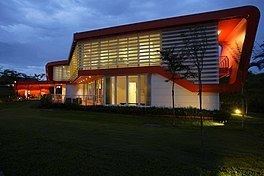Country Malaysia Floor count 2 Opened June 2010 Architectural style Sustainable architecture Client Sime Darby Property | Completed Jun 2010 Floor area 710 m (7,600 sq ft) Floors 2 Construction started January 2010 Architect Jason Pomeroy | |
 | ||
Similar National Zoo of Malaysia, Sunway Lagoon, Trump Tower Manila | ||
The Idea House is Asia’s first carbon neutral prototype residence, and is located on the outskirts of Malaysia’s capital city, Kuala Lumpur, in Denai Alam, Selangor. The Idea House was designed by Prof Jason Pomeroy, an award-winning architect and academic specialising in sustainable design, while he was a director of the architecture firm Broadway Malyan. The project was built by the Malaysian developers Sime Darby Property, in a record eight weeks
Contents
Originally conceived as a test bed for new ideas and a showcase for sustainable architecture in Southeast Asia, the Idea House fundamentally embraces passive techniques used in Malaysia’s traditional Kampung houses, which were then balanced with the latest green technology innovations in order to reduce stress on the environment and natural resources. It is also a response by the building industry to address the major environmental issues caused by the built environment, and to consumer demand for greener, more sustainable buildings.
Kampong house inspiration
The Idea House drew inspiration from the passive design techniques of the traditional Malay Kampong house. Deep overhanging roofs provide shade from the sun and rain, while large roof volumes allows for greater air circulation. A long extruded rectangular floor plan with veranda spaces further permit a minimal amount of solar heat gain - especially when the shorter facades are orientated east and west. The plan also allows for cross ventilation across the shorter sides.
Combining passive design with active technology
Passive design techniques originally employed in the Malay Kampong house were combined with modern technology to create a home that is not only very low in energy and water consumption, but also generates enough renewable energy to offset the operational requirements of its five occupants. Specific techniques include rainwater and greywater harvesting that reduces potable water consumption by 98%. The house’s orientation minimises solar heat gain, with the shorter sides of the building facing east-west - thus lowering exposure to the sun and reducing cooling loads. The living spaces are orientated in a south-westerly direction so as to harness the southwest wind that takes place 80% of the year. Such a passive approach seeks to reduce consumption by 52% in overall energy usage as compared to a similar sized house of a conventional specification.
The photovoltaic cells located on the roof provide 20,724 kilowatt hours of energy (based on monthly performance of 1,727kWh per month) – enough to offset the needs of not only a family of 5, but also create an energy surplus of approximately 3,924kWh per year.
Book
Upon the buildings’ completion, Pomeroy authored a book that recorded the design process of the zero-carbon prototype, along with imagery and photographs of the completed structure and its post occupancy analysis. ‘Idea House: Future Tropical Living Today’ was published by Oro Editions in 2011.
Awards
Innovation
